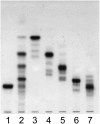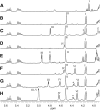Biochemical studies on sphingolipids of Artemia franciscana: novel neutral glycosphingolipids
- PMID: 21062954
- PMCID: PMC3023551
- DOI: 10.1194/jlr.M010173
Biochemical studies on sphingolipids of Artemia franciscana: novel neutral glycosphingolipids
Abstract
Neutral glycosphingolipids containing one to six sugars in their oligosaccharide chains have been isolated from cysts of the brine shrimp Artemia franciscana. The structures of these glycolipids were identified by methylation analysis, partial acid hydrolysis, gas-liquid chromatography, combined gas-liquid chromatography-mass spectrometry, matrix-assisted laser desorption/ionization time-of-flight mass spectrometry, and proton nuclear magnetic resonance spectroscopy to be Glcβ1-Cer, Manβ1-4Glcβ1-Cer, Fucα1-3Manβ1-4Glcβ1-Cer, GlcNAcβ1-3Manβ1-4Glcβ1-Cer, GlcNAcα1-2Fucα1-3Manβ1-4Glcβ1-Cer, GalNAcβ1-4GlcNAcβ1-3Manβ1-4Glcβ1-Cer, GalNAcβ1-4(Fucα1-3)GlcNAcβ1-3Manβ1-4Glcβ1-Cer (CPS), and GalNAcβ1-4(GlcNAcα1-2Fucα1-3)GlcNAcβ1-3Manβ1-4Glcβ1-Cer (CHS). Two glycosphingolipids, CPS and CHS, were characterized as novel structures. Because Artemia contains a certain series of glycosphingolipids (-Fucα3Manβ4GlcβCer), which differ from the core sugar sequences reported thus far, we tentatively designated the glycosphingolipids characterized as nonarthro-series ones. Furthermore, CHS exhibited a hybrid structure of arthro-series and nonarthro-series sugar chain. Two novel glycosphingolipids were characterized from the brine shrimp Artemia franciscana; one was composed of arthrotetraose and a branching fucose attached to N-acetylglucosamine residue, and the other was composed of CPS with an additional N-acetylglucosamine residue attached to the branching fucose.
Figures





Similar articles
-
Biochemical studies on sphingolipids of Artemia franciscana: complex neutral glycosphingolipids.Glycoconj J. 2013 Apr;30(3):257-68. doi: 10.1007/s10719-012-9436-8. Epub 2012 Aug 14. Glycoconj J. 2013. PMID: 22890904 Free PMC article.
-
The Drosophila gene brainiac encodes a glycosyltransferase putatively involved in glycosphingolipid synthesis.J Biol Chem. 2002 Sep 6;277(36):32421-9. doi: 10.1074/jbc.M206213200. Epub 2002 Jul 18. J Biol Chem. 2002. PMID: 12130651
-
A novel fucosyl glycosphingolipid of brine shrimp that is highly sensitive to endoglycoceramidase.Glycobiology. 2009 Dec;19(12):1446-51. doi: 10.1093/glycob/cwp118. Epub 2009 Aug 21. Glycobiology. 2009. PMID: 19700487
-
Structural elucidation of the neutral glycosphingolipids, mono-, di-, tri- and tetraglycosylceramides from the marine crab Erimacrus isenbeckii.J Oleo Sci. 2014;63(3):269-80. doi: 10.5650/jos.ess13156. Epub 2014 Feb 3. J Oleo Sci. 2014. PMID: 24492377
-
Insect glycolipids.Biochim Biophys Acta. 1992 Jan 24;1123(2):117-26. doi: 10.1016/0005-2760(92)90101-z. Biochim Biophys Acta. 1992. PMID: 1739742 Review.
Cited by
-
Biochemical studies on sphingolipids of Artemia franciscana: complex neutral glycosphingolipids.Glycoconj J. 2013 Apr;30(3):257-68. doi: 10.1007/s10719-012-9436-8. Epub 2012 Aug 14. Glycoconj J. 2013. PMID: 22890904 Free PMC article.
-
Lipid Profile Changes During the Development of Artemia franciscana, From Cysts to the First Two Naupliar Stages.Front Physiol. 2019 Jan 22;9:1872. doi: 10.3389/fphys.2018.01872. eCollection 2018. Front Physiol. 2019. PMID: 30723418 Free PMC article.
-
The Structural Diversity of Natural Glycosphingolipids (GSLs).J Carbohydr Chem. 2022;41(2-3):63-154. doi: 10.1080/07328303.2022.2063308. Epub 2022 May 26. J Carbohydr Chem. 2022. PMID: 36561362 Free PMC article.
References
-
- Hakomori S. 2000. Cell adhesion/recognition and signal transduction through glycosphingolipid microdomain. Glycoconj. J. 17: 143–151. - PubMed
-
- Kawano T., Cui J., Koezuka Y., Toura I., Kaneko Y., Motoki K., Ueno H., Nakagawa R., Sato H., Kondo E., et al. 1997. CD1d-restricted and TCR-mediated activation of Vα14 NKT cells by glycosylceramides. Science. 278: 1626–1629. - PubMed
-
- Yu R. K., Yanagisawa M., Ariga T. 2007. Glycosphingolipid structures. Comprehensive Glycoscience 1: Introduction to Glycoscience Synthesis of Carbohydrates. Kamerling J. P. editor Elsevier, Oxford: 73–122.
-
- Itonori S., Sugita M. 2007. Glycophylogenetic aspects of lower animals. Comprehensive Glycoscience 3: Biochemistry of Glycoconjugate Glycans Carbohydrate-mediated Interactions. Kamerling J. P., editor Elsevier, Oxford. U.K: 253–284.
Publication types
MeSH terms
Substances
LinkOut - more resources
Full Text Sources

